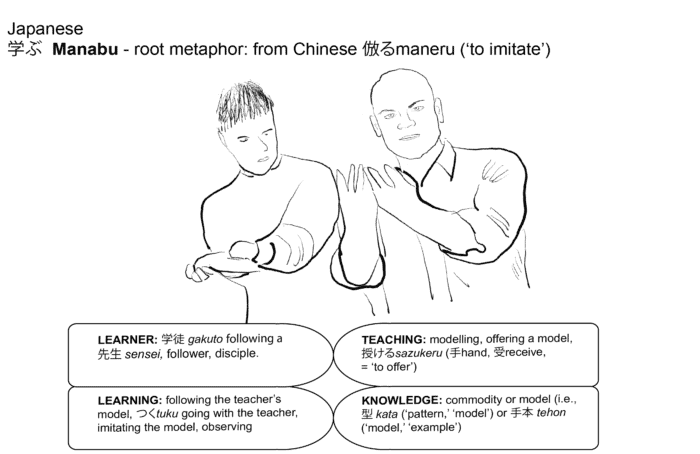Root Metaphor
学ぶ (Manabu) from the Chinese 倣るmaneru (‘to imitate’).Illustrative Example of Root Metaphor


Etymology
Both 学ぶ manabu (‘to study’) and 習narau (‘to learn’), come from the Chinese characters 倣るmaneru (‘to imitate’) and 慣れるnareru (‘to get accustomed’). The Chinese character 倣るmaneru originally represents an act of making a child learn or imitate hand gestures according to the norms of society. 慣れるNareru represents a bird flapping its wings to practice flying which leads to notions of practicing, repeating and getting accustomed.Common phrases
- 見習う mi-narau (see.learn) – ‘to watch and learn’ or ‘to observe and imitate.’ (Hirago, 2008, p.64)
- お兄さんを見習いなさい onii-san o minarai-nasai (elder brother watch learn) – ‘learn by observing your elder brother’ (p.64)
- 型から入って、型を出る。 kata kara hait-te, kata o deru (model from enter, model exit) – ‘To enter by imitating the model, and exit out of the model.’ (p. 63)
- 先輩を見習って君も一所懸命勉強しなさい senpai-tati o minarat-te kimi mo issyookenmei benkyoo si-nasai (senior student watch learn you too hard study do) – ‘you should study hard, too, by observing your seniors’ (p. 64)
- 学びの窓 manabi no mado (learning window ) – place of learning (p.67)
Commentary
学ぶ (Manabu) invokes the notion of a novice-expert where learning is about imitating the expert. The etymology implies that there are at least two individuals (a teachers and a student). It also implies a passive and receptive attitude of learning where the student follows the teacher imitates the teacher’s model (i.e., 型kata (‘pattern,’ ‘model’) or 手本 tehon (‘mod- el,’ ‘example’)). 授けるsazukeru (手hand, 受receive,= ‘to offer’). Thus, the teacher’s role is to model or to offer a model, a skill, wisdom or knowledge. Learning is the responsibility of the learner. Copying the model is a common practice with Japanese traditional arts. For instance, there are no written instructions for a tea ceremony. The learner just keeps observing/copying/practicing until the teacher/master tells them they have the ceremony right. Only after mastering the ceremony, can the learner modify the ceremony.Implicit Spatial Associations
The metaphor or learn involves two people - so a relationship is necessary.Sources
Hiraga, M.K. (2008). Metaphors Japanese students live by. In Berendt, E.A. (Ed.) Metaphors for learning cross-cultural perspectives. John Benjamins Publishing company. pp 55-72.Please cite this article as:
Davis, B., & Francis, K. & Takeuchi, M. (2020). “Manabu 学ぶ" (Japanese). In Metaphors of Learning in Different Languages. https://doi.org/10.11575/8B7N-V637. https://learningmetaphors.com
⇦ Back to Map
⇦ Back to List
